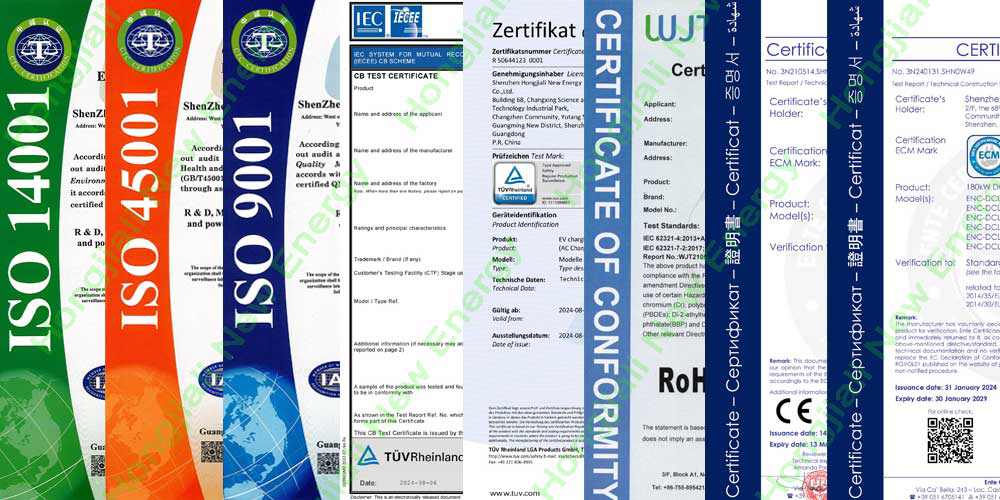The following is a detailed introduction to the energy storage system of charging piles:
1. System composition
The energy storage system of charging piles usually consists of the following key parts:
Energy storage device: This is the core component of the system, which is used to store electrical energy. There are many types of energy storage devices, including lead-acid batteries, nickel-metal hydride batteries, lithium-ion batteries, etc. Among them, lithium-ion batteries have become the mainstream energy storage device due to their high energy density, long life and environmental protection.
Charging pile: Charging pile is another important component of the charging pile energy storage system, which is responsible for providing charging interface for electric vehicles. The power and current of the charging pile directly affect the charging speed and efficiency of electric vehicles. Charging piles are mainly divided into two types: AC charging piles and DC charging piles. AC charging piles have a slower charging rate and are suitable for places such as homes or parking lots; DC charging piles have a faster charging rate and are more suitable for scenes with higher requirements for charging time, such as taxis and buses.
Power conversion system (PCS): responsible for the conversion and management of electric energy, including DC-AC conversion and reverse conversion, to achieve the storage and release of electric energy.
Battery management system (BMS): responsible for monitoring and managing the status of energy storage batteries, including battery charging, discharging, temperature, health, etc. BMS can ensure the safe and stable operation of the battery system and prevent abnormal conditions such as overcharging and over-discharging.
Intelligent control system: using advanced Internet of Things technology and artificial intelligence algorithms to achieve remote monitoring, fault diagnosis, intelligent scheduling and other functions of charging piles. The intelligent control system can automatically identify the vehicle type, battery capacity and remaining power, intelligently adjust the charging speed and time, and improve charging efficiency and safety.
2. Working principle
When the charging pile energy storage system is working, it can obtain electric energy from the power grid, solar photovoltaic system or other renewable energy devices and store it in the battery. When the electric vehicle needs to be charged, the energy storage system transmits the stored electric energy to the charging interface through the power conversion system to achieve fast charging of the vehicle.
3. System advantages
Improve charging efficiency: The charging speed of traditional charging piles is limited by the power supply capacity of the power grid, while the charging pile energy storage system can use the energy storage system to provide high power output, achieve fast charging, and greatly shorten the charging time.
Relieve grid pressure: During peak power consumption, charging electric vehicles directly from the power grid will cause great load pressure. The charging pile energy storage system can charge during low power consumption periods and then release energy during peak periods, thereby effectively alleviating grid pressure.
Optimize energy utilization: The charging pile energy storage system can be charged in combination with renewable energy such as solar energy and wind energy to improve the utilization rate of green energy, reduce dependence on fossil fuels, and reduce carbon emissions.
Emergency backup power supply: In the event of a power grid failure or power outage, the charging pile energy storage system can be used as an emergency backup power supply to provide continuous power supply for electric vehicles and other key equipment.
4. Application scenarios
The application scenarios of the charging pile energy storage system are wide, including but not limited to:
Residential communities: Provide residents with convenient charging services to meet daily travel needs.
Commercial centers: Deployed in commercial areas such as shopping centers and office buildings to provide fast charging services for electric vehicle users.
Large parking lots: Deployed in large parking lots such as airports and train stations to provide charging services for electric vehicles on long-distance trips.
Highway service areas: Provide fast charging services for electric vehicles on long-distance trips to improve the coverage and convenience of the charging network.
Remote and off-grid areas: In remote areas where the power grid is not covered or the power supply is unstable, combined with renewable energy systems, provide reliable charging services for local residents and tourists.
 +86 18924678741
+86 18924678741 sales@hjlcharger.com
sales@hjlcharger.com Shenzhen City, Guangdong Province, China
Shenzhen City, Guangdong Province, China







